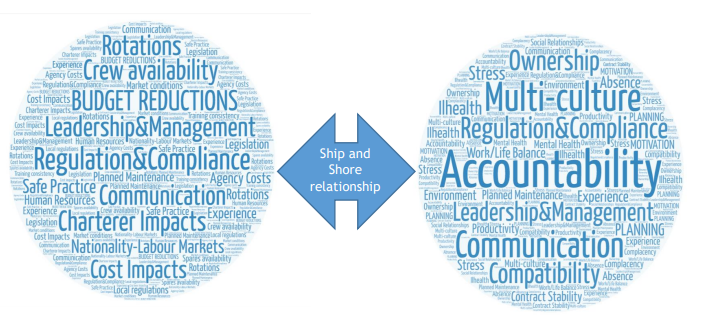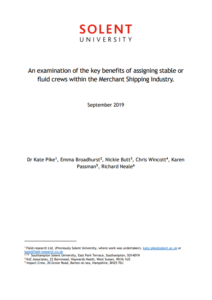The Effective Crew Project, led by Solent University, analyzes the benefits and challenges regarding the implementation of either a stable or a fluid crewing strategy on board merchant vessels. The project began in April 2017, aiming to develop findings from a pilot study carried out, while also drawing upon best practice from stakeholders within the maritime industry.
Data will also be examined from other industries, in order to compare best practice and draw on lessons learned for the maritime industry to enhance safety, welfare and efficiency at sea.
[smlsubform prepend=”GET THE SAFETY4SEA IN YOUR INBOX!” showname=false emailtxt=”” emailholder=”Enter your email address” showsubmit=true submittxt=”Submit” jsthanks=false thankyou=”Thank you for subscribing to our mailing list”]
The focus was on vessels types with over 20 crew including: tankers, car carriers, containers, bulk carriers and chemical carriers, although some additional data was collected. The research incorporated a review of literature and collected data from an industry wide survey and 29 interviews with maritime stakeholders and experts from other industries, including healthcare and aviation.
The Effective Crew Project indicated that stable manning strategies can be cost effective and led to clear benefits:
- For safety outcomes: With improved accountability and responsibility, leading to better vessel maintenance and familiarity with vessel and equipment;
- For the well-being and competency of the crew: With higher retention rates, a greater sense of ownership, familiarity, trust and loyalty, and increased capacity for on the job learning and mentoring;
- For longer term financial savings: With improved inspection results, reduced training and recruitment, and improved operational costs.
Nevertheless, the research also pointed out several factors that impact the success of stable crewing, including:
- The effectiveness of the leadership and management skills on board or ashore: This needs to be current and sensitive to continuous crew development and efficient vessel operations;
- The expansion or reduction in fleet size: Crew stability can be difficult to maintain;
- The ability to accurately measure the financial implications of different crewing strategies: This will enable accurate evaluation of a crewing strategy.
In addition, team familiarity provided through stable crewing is able to advance trust and good working relations, thus increasing productivity and enhancing mental health outcomes for the crew.
Moreover, the project shows that other benefits from stable teams included improved vessel maintenance and reduced maintenance costs as well as shorter handover times and recruitment costs.
However, these outcomes have longer term financial benefits for ship operations and the shipping company. But, those applying stable teams, especially for the top 4 senior officers, should be aware that this can mean lead to less promotional opportunities and, as a further result an increased risk of complacency.
Although there are some clear benefits to stable crewing, the uniqueness of individual shipping companies means that one size does not fit every situation. It is therefore vital that crewing strategies are continuously and consistently evaluated and adjusted where necessary. Changes to a different crewing strategy, or combination of strategies within a fleet, should be considered if evaluation highlights this as the best option for maximising cost efficiency, safety and crew well-being
the project explains.
What is more, the team noted that no matter what the manning strategy is, it is important to recognise the influence that leadership and management can have on on board culture. Specifically, substandard leadership, in spite of the crewing strategy implemented, can dramatically affect crew well-being and safety and ultimately on the budget.
Summarizing the key findings from the Effective Crew Project, the team gives emphasis on the following ten:
- The research shows that there are some clear, measurable benefits to stable crewing for safety outcomes, crew well-being and long-term financial performance, although this is not applicable to every shipping company. One size does not fit all, and each shipping company will have their own set of conditions to consider when planning the best crewing strategy, based on their specific requirements such as vessel type, fleet size and trading patterns.
- The use of consistent data and metrics is necessary to evaluate the success of changing manning strategies. Without these it is difficult to accurately measure cost savings.
- Many companies are not collecting reliable data over time to inform their crewing strategies. The metrics used may be consistent, but the research has shown that unexpected events, such as unscheduled engine maintenance, can impact the statistics and generate unreliable data.
- Stable crewing often means that new relationships between ship and shore are developed. Crew going back to the same vessel have an increased sense of ownership and responsibility, which can promote better communications which is reflected in their relationship with the office. The value of the ‘sense of belonging’ has positive repercussions for crew wellbeing.
- Stable crewing reduces handover times and increases crew retention however, promotion opportunities maybe restricted by the lack of ‘movement’ amongst the top four senior officers and especially if stability extends beyond this to other ranks.
- Stable crewing can reduce recruitment and training costs.
- Familiarity with procedures on board was shown to strengthen the on-board safety culture.
- Reducing staff turn-over through maintaining stable crews offers opportunity to develop stronger mentoring relationships on board, build trust and extend support networks.
- Complacency associated with stable crewing has been shown to become an issue over time if stable teams exceed their optimum time to stay together. The optimum time, suggested by the research, was approximately two and a half years, beyond which can lead to complacency, the normalisation of deviance and compromise to safety standards.
- The benefits of implementing a stable or fluid crewing strategy were directly linked to leadership behaviour among the top four senior officers This has significant impact upon the on-board culture, with repercussions greatly influencing crew welfare and safety.
Recommendations
Continuing, the project also concluded to specific recommendations, which include greater support for the senior officers both from shore side personnel, and on-going leadership training and development. More specifically:
- Work is needed to develop measures that accurately assess the overall performance of a vessel and the impact of the crewing strategy adopted, so that decisions concerning crewing are better understood, implemented and evaluated.
- Investment in on-going leadership and management development for all those responsible for leading teams on board and ashore is recommended to help establish the best working and safety cultures for whichever crewing strategy is in place.
- Collaboration, between industry leading shipping companies that are operating stable crewing and working to improve safety and well-being standards, is recommended to share information and best practice to others.
- The research offers conclusive evidence that stable crewing can improve safety, well-being, and over time, financial outcomes. However, as the report mentions putting hard figures against the cost benefits has been problematic due to inconsistent data sets provided by the case-studies and measurements taken over time. Future research, using shipping companies that operate both fluid and stable crewing and carefully defined comparative metrics, should be conducted within the same fleet to generate data of the cost benefits of different crewing strategies.
For more information, click in the following PDF


































































